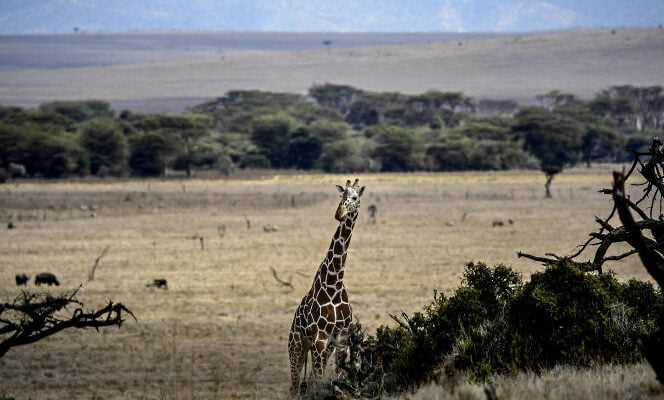To not miss any African news, subscribe to the newsletter of the World Africa from this link. Every Saturday at 6 a.m., find a week of news and debates covered by the editorial staff of the World Africa.
Kenya is renowned for its expanses of savannah where the “Big Five” coexist, symbols of the African safari where we find the lion, the leopard, the elephant, the rhinoceros and the buffalo. Today, four of these species are classified as vulnerable or threatened with extinction. The fifth, the buffalo, is not there yet, but the animal is now one of the hardest hit by the drought in the north of the country.
“He’s a big ruminant, so he’s very weak when there’s no grass. Sometimes he also gets stuck in the mud of the waterholes almost dry to the point of dying on the spot », says Sharmake Yussuf, chairman of the Sabuli Nature and Community Reserve in Wajir County.
After three disappointing rainy seasons in the north of the country, wildlife and herbivores in particular are suffering from the lack of resources and the resulting exacerbated insecurity, falling prey to hunters. “We lost between ten and fifteen Grevy’s zebras. For any other species it doesn’t matter, but when there are only 3,000 of these animals left alive across the world, every loss counts.”, laments David Kimiti about this endangered species that lives in Kenya and Ethiopia.
The Grevy Zebra trust (GZT), of which he is deputy director for research, distributed supplementary fodder to wild herds daily from August to December 2021, monitoring their physical condition and the evolution of vegetation. Staff from the Sabuli reserve organized water distributions by truck in November and December.
Dying of hunger, thirst, disease
The last wet period, the most important of the two annual seasons in this part of the country, traditionally occurs from October to December but was late and sparse this year in the counties of Garissa, Wajir, Mandera, Isiolo, Marsabit, Samburu and Turkana. As the country now enters the dry season, “Where we operate in Marsabit, Samburu and Isiolo, some areas have had very little rainfall for the past two years, to the point where people say it hasn’t rained at all”, comments Antony Wandera, in charge of animal surveillance for the North Rangelands Trust (NRT), an organization comprising the forty-three community reserves in the north and coast.
In this context, wild animals perish from hunger and thirst, but also from disease, malnutrition making them vulnerable. “When the weather is really dry and there is a concentration of animals feeding directly on the ground, it is really dangerous”, analyzes Antony Wandera, with particular reference to anthrax, a staphylococcal infection that can be transmitted to humans.
The Sabuli conservatory counted the losses within the reserve between August and January: thirty-five giraffes, thirty-eight oryx, thirteen Waller’s gazelles (long-tailed antelope), eight lesser kudu (spiral-horned antelope ), fifty-two warthogs and four ostriches. Throughout the northeast region, more than two hundred giraffes, including the endangered reticulates, died between October and December 2021.
But it is above all the hirolas, nicknamed “the four-eyed antelope”, which worries Sharmake Yussuf, also president of the Northeast Conservatory Association (NECA): “There are only five hundred left in the world, all in northern Kenya. We lost about thirty in 2021, it is 6% of their population. »
Drought fuels tensions
Could this situation have been avoided? “We cannot completely manage the problem of drought, because the seasons change and the weather forecast sometimes turns out to be wrong”, recognizes Edwin Wanyonyi, director of strategy for the Kenya Wildlife Service (KWS, the government agency for the protection of wildlife). Otherwise, a special effort is made to improve the cohabitation between humans and wild animals.
Conservation specialists involve local communities in nature protection to increase their level of tolerance towards animals. This national movement is bearing fruit with a reduction in poaching of elephants and rhinos by 90% between 2012 and 2019 according to a KWS survey. But Covid-19 and drought are reversing the trend.
“When people get desperate, they look for any way out”, explains David Kimiti. Giraffes in Wajir County are particularly targeted. Sharmake Yussuf details: “Poachers come from Somalia, kill the animals and sell the meat there. » Some said he earns around 1,800 shillings (about 14 euros) per kilo.
The drought is fueling tensions and wildlife organizations sometimes struggle to access areas where animals are. “It happened that one of our vehicles was shot at while we are neutral actors. It forces us to be careful.”, evokes David Kimiti.
After the low rainfall in December, aridity continues to gain ground in northern Kenya. Local organizations are now hoping for inter-seasonal rains or an early spring rainy season to be able to carry out their conservation mission.
